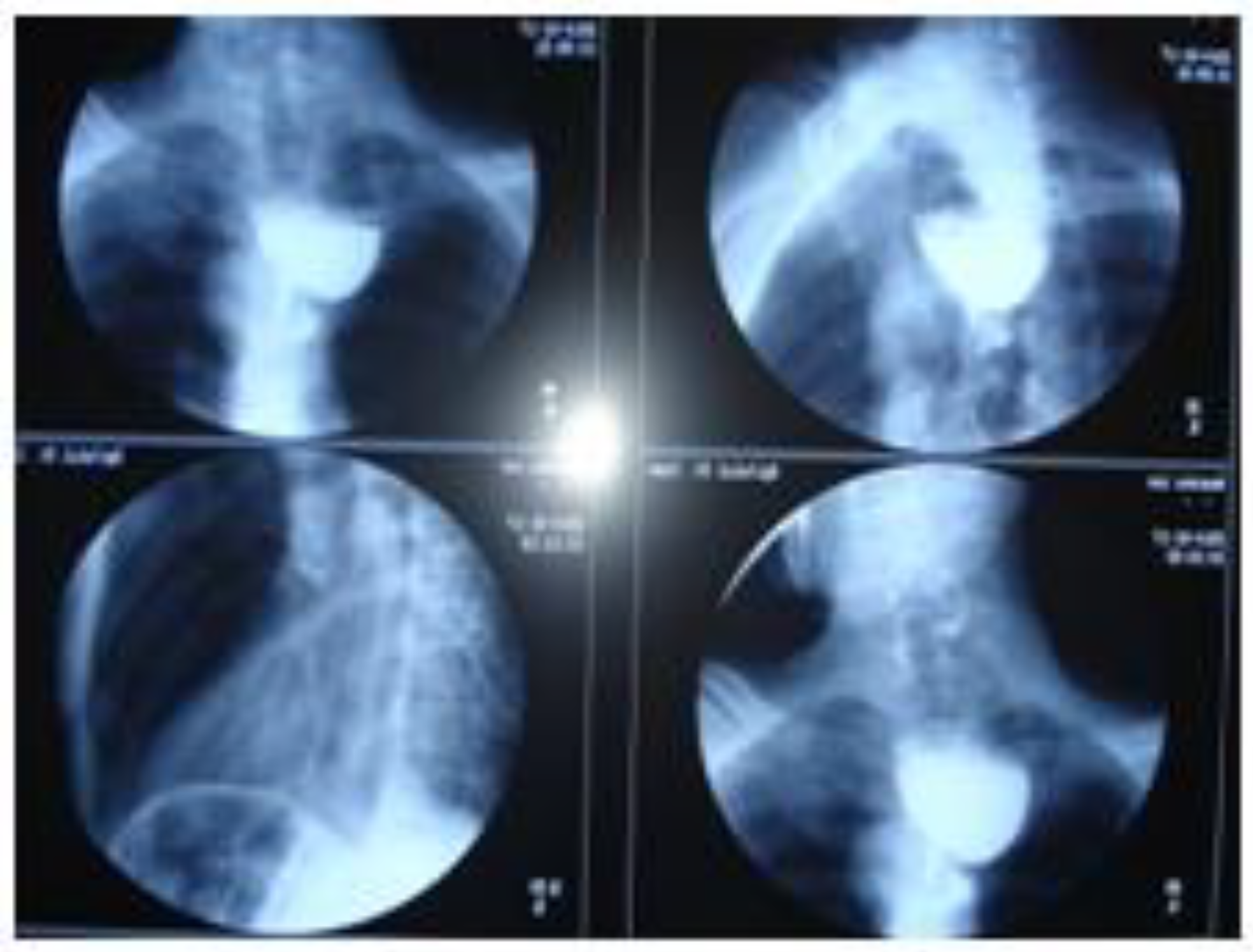Zenker’s Diverticulum and Squamous Esophageal Cancer: A Case Report
Abstract
:Introduction
Case Report
Discussion
Conclusions
References
- Albers, D.V.; Kondo, A.; Bernardo, W.M.; Sakai, P.; Moura, R.N.; Silva, G.L.; Ide, E.; Tomishige, T.; de Moura, E.G. Endoscopic versus surgical approach in the treatment of Zenker's diverticulum: systematic review and meta-analysis. Endosc Int Open. 2016, 4, E678–86. [Google Scholar] [CrossRef] [PubMed]
- Dzeletovic, I.; Ekbom, D.C.; Baron, T.H. Flexible endoscopic and surgical management of Zenker's diverticulum. Expert Rev Gastroenterol Hepatol. 2012, 6, 449–65, quiz 466. [Google Scholar] [CrossRef] [PubMed]
- Anagiotos, A.; Preuss, S.F.; Koebke, J. Does the hypopharyngeal cavernous body protect the development of Zenker's diverticulum? Auris Nasus Larynx. 2013, 40, 93–7. [Google Scholar] [CrossRef] [PubMed]
- Beard, K.; Swanström, L.L. Zenker's diverticulum: flexible versus rigid repair. J Thorac Dis. 2017, 9, S154–S162. [Google Scholar] [CrossRef] [PubMed]
- Goelder, S.K.; Brueckner, J.; Messmann, H. Endoscopic treatment of Zenker's diverticulum with the stag beetle knife (sb knife) - feasibility and follow-up. Scand J Gastroenterol. 2016, 51, 1155–8. [Google Scholar] [CrossRef] [PubMed]
- Ferreira, L.E.; Simmons, D.T.; Baron, T.H. Zenker's diverticula: pathophysiology, clinical presentation, and flexible endoscopicmanagement. Dis Esophagus 2008, 21, 1–8. [Google Scholar] [CrossRef] [PubMed]
- Scher, R.L. Zenker Diverticulum and Clinical Controversies in Otolaryngology: Which Surgical Approach Is Superior? JAMA Otolaryngol Head Neck Surg. 2016, 142, 403–4. [Google Scholar] [CrossRef] [PubMed]
- Herbella, F.A.; Dubecz, A.; Patti, M.G. Esophageal diverticula and cancer. Dis Esophagus. 2012, 25, 153–8. [Google Scholar] [CrossRef] [PubMed]
- Vogelsang, A.; Schumacher, B.; Neuhaus, H. Therapy of Zenker’s Diverticulum. Dtsch Arztebl Int. 2008, 105, 120–6. [Google Scholar] [CrossRef] [PubMed]
- Gutschow, C.A.; Hamoir, M.; Rombaux POtte, J.B.; Goncette, L.; Collard, J.M. Management of pharyngoesophageal (Zenker's) diverticulum: which technique? Ann Thorac Surg. 2002, 74, 1677–82, discussion 1682-1683. [Google Scholar] [CrossRef] [PubMed]
- Vogelsang, A.; Preiss, C.; Neuhaus HSchumacher, B. Endotherapy of Zenker's diverticulum using the needle-knife technique: long-term follow-up. Endoscopy. 2007, 39, 131–6. [Google Scholar] [CrossRef] [PubMed]
- Higuchi, K.; Koizumi, W.; Tanabe SSasaki, T.; Katada, C.; Azuma, M.; Nakatani, K.; Ishido, K.; Naruke, A.; Ryu, T. Current Management of Esophageal Squamous- Cell Carcinoma in Japan and Other Countries. Gastrointest Cancer Res. 2009, 3, 153–61. [Google Scholar] [PubMed]
- Iwanski, G.B.; Block, A.; Keller GMuench, J.; Claus, S.; Fiedler, W.; Bokemeyer, C. Esophageal squamous cell carcinoma presenting with extensive skin lesions: a case report. J Med Case Rep. 2008, 2, 115. [Google Scholar] [CrossRef] [PubMed]
- Holeab, C.; Paunica, M.; Curaj, A. A complex method of semantic bibliometrics for revealing conceptual profiles and trends in scientific literature. The case of future-oriented technology analysis (FTA) science. Economic computation and economic cybernetics studies and research. 2017, 51, 23–37. [Google Scholar]



© 2017 by the author. 2017 Ion Dina, Octav Ginghina, Corina D. Toderescu, Cristian Bălălău, Bianca Galateanu, Carolina Negrei, Claudia Iacobescu
Share and Cite
Dina, I.; Ginghina, O.; Toderescu, C.D.; Bălălău, C.; Galateanu, B.; Negrei, C.; Iacobescu, C. Zenker’s Diverticulum and Squamous Esophageal Cancer: A Case Report. J. Mind Med. Sci. 2017, 4, 193-197. https://doi.org/10.22543/7674.42.P193197
Dina I, Ginghina O, Toderescu CD, Bălălău C, Galateanu B, Negrei C, Iacobescu C. Zenker’s Diverticulum and Squamous Esophageal Cancer: A Case Report. Journal of Mind and Medical Sciences. 2017; 4(2):193-197. https://doi.org/10.22543/7674.42.P193197
Chicago/Turabian StyleDina, Ion, Octav Ginghina, Corina D. Toderescu, Cristian Bălălău, Bianca Galateanu, Carolina Negrei, and Claudia Iacobescu. 2017. "Zenker’s Diverticulum and Squamous Esophageal Cancer: A Case Report" Journal of Mind and Medical Sciences 4, no. 2: 193-197. https://doi.org/10.22543/7674.42.P193197
APA StyleDina, I., Ginghina, O., Toderescu, C. D., Bălălău, C., Galateanu, B., Negrei, C., & Iacobescu, C. (2017). Zenker’s Diverticulum and Squamous Esophageal Cancer: A Case Report. Journal of Mind and Medical Sciences, 4(2), 193-197. https://doi.org/10.22543/7674.42.P193197


